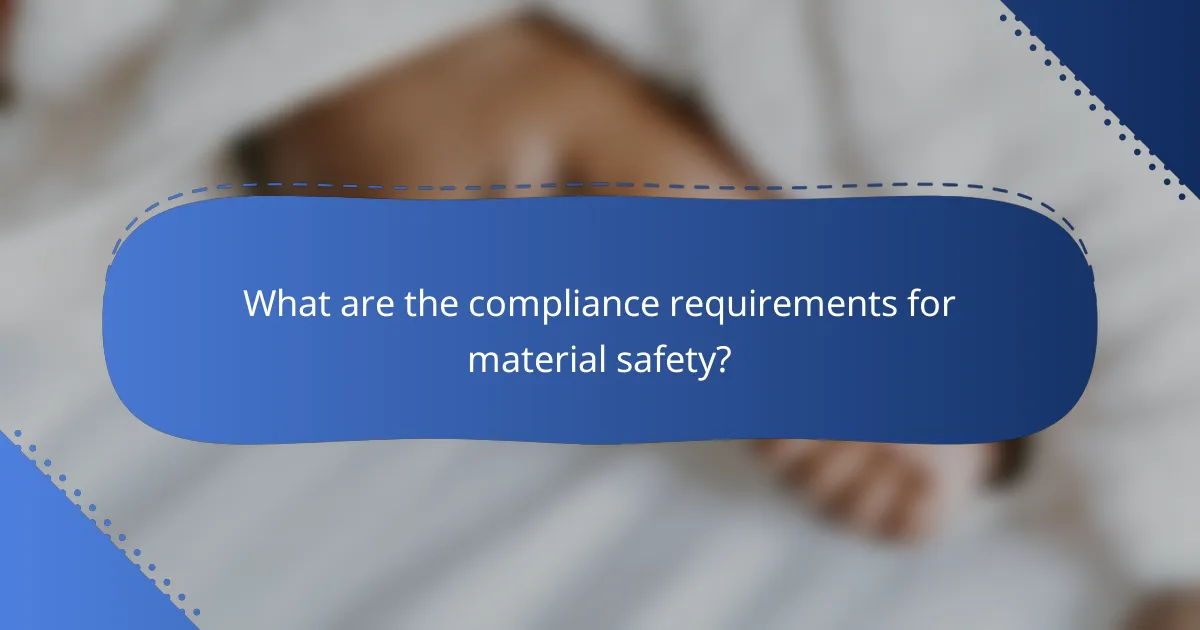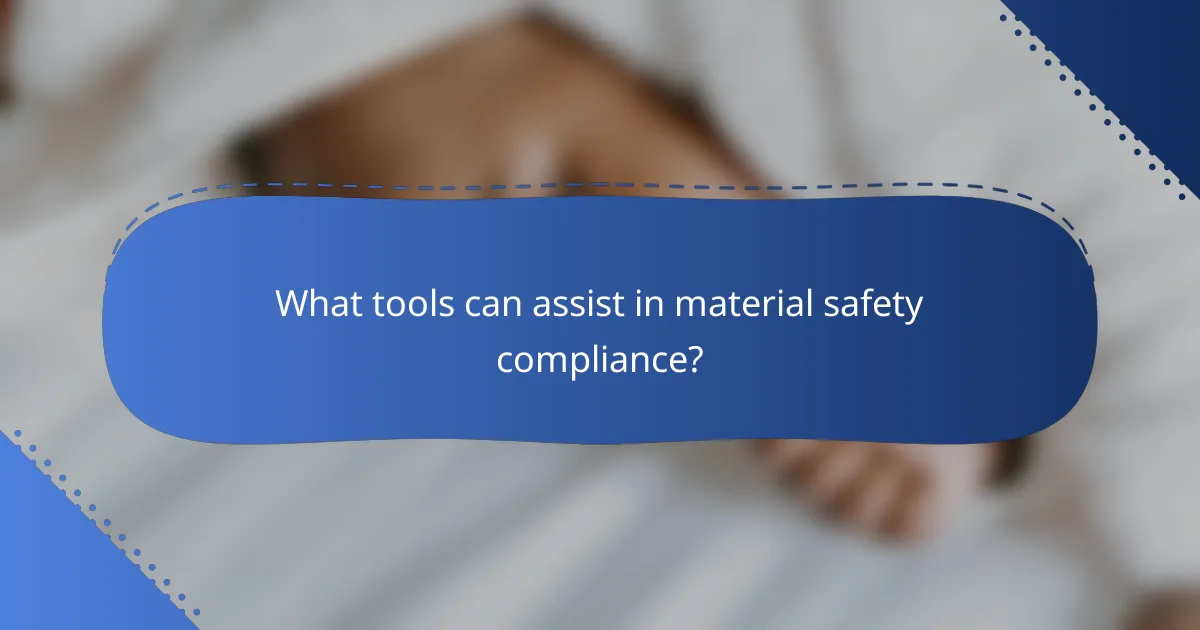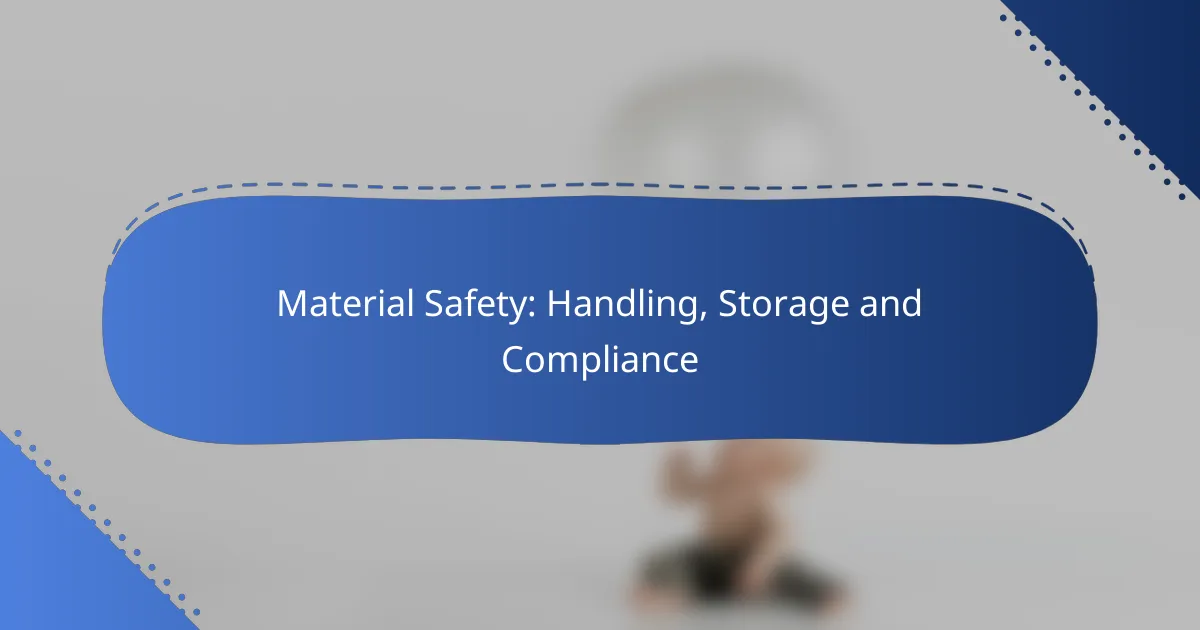Ensuring material safety is crucial for minimizing risks and maintaining compliance with regulations. This involves implementing best practices for handling and storage, including the use of personal protective equipment and proper labeling. Additionally, adherence to compliance requirements is essential for the safe management of hazardous materials, protecting both workers and the environment.

What are the best practices for material safety handling?
Best practices for material safety handling focus on minimizing risks and ensuring compliance with regulations. This involves using appropriate personal protective equipment, proper labeling, effective training, and established emergency procedures.
Personal protective equipment (PPE) usage
Using personal protective equipment (PPE) is essential for safeguarding workers from exposure to hazardous materials. Common PPE includes gloves, goggles, masks, and protective clothing, which should be selected based on the specific materials being handled.
Regularly inspect PPE for wear and tear, and replace items as needed to maintain effectiveness. Ensure that all employees are trained on the correct use and limitations of the PPE provided.
Proper labeling and signage
Proper labeling and signage are critical for communicating hazards associated with materials. Labels should clearly indicate the contents, hazards, and handling instructions, following standards such as OSHA’s Hazard Communication Standard.
Use standardized symbols and colors to enhance visibility and understanding. Ensure that all containers are labeled before use and that signage is placed in prominent locations to inform workers of potential dangers.
Training and education programs
Training and education programs are vital for ensuring that employees understand material safety protocols. Regular training sessions should cover safe handling practices, emergency procedures, and the proper use of PPE.
Consider implementing refresher courses annually or whenever new materials or processes are introduced. Engaging employees through hands-on training can improve retention and compliance with safety practices.
Emergency response procedures
Establishing clear emergency response procedures is crucial for minimizing the impact of accidents involving hazardous materials. These procedures should outline steps for containment, evacuation, and communication in case of spills or exposure incidents.
Conduct regular drills to ensure all employees are familiar with the emergency protocols. Additionally, maintain accessible emergency equipment, such as spill kits and first aid supplies, to facilitate prompt action during an incident.

How should materials be stored safely?
Materials should be stored safely by following guidelines that minimize risks of accidents, contamination, or degradation. Key considerations include maintaining appropriate environmental conditions, ensuring compatibility between stored items, and using suitable containers.
Temperature and humidity control
Controlling temperature and humidity is essential for the safe storage of many materials. For instance, chemicals may require storage in cool, dry environments to prevent reactions or degradation. Regular monitoring of these conditions can help maintain stability and safety.
Use thermometers and hygrometers to track temperature and humidity levels. Aim for specific ranges based on the material’s requirements; for example, a temperature range of 15-25°C and humidity below 60% is often ideal for many substances.
Segregation of incompatible materials
Incompatible materials should be stored separately to prevent dangerous reactions. For example, acids should not be stored near bases, and flammable substances should be kept away from oxidizers. This segregation reduces the risk of accidents and enhances safety.
Utilize clear labeling and designated storage areas to avoid confusion. Implement a color-coding system for easy identification of incompatible materials, ensuring that staff can quickly recognize and adhere to safety protocols.
Use of appropriate containers
Using the right containers is crucial for safe material storage. Containers should be made from materials that resist corrosion, leakage, and breakage, depending on the stored substance. For example, glass or high-density polyethylene (HDPE) containers are often suitable for chemicals.
Ensure that all containers are clearly labeled with contents, hazard warnings, and handling instructions. Regularly inspect containers for signs of wear or damage, and replace any that show deterioration to maintain safety standards.

What are the compliance requirements for material safety?
Compliance requirements for material safety involve adhering to regulations and guidelines that ensure safe handling, storage, and disposal of hazardous materials. These requirements are essential for protecting workers, the environment, and the community.
OSHA regulations
The Occupational Safety and Health Administration (OSHA) sets forth regulations that govern workplace safety, including the handling of hazardous materials. Employers must implement a Hazard Communication Standard (HCS) to inform employees about the risks associated with chemicals they may encounter.
Key components of OSHA regulations include maintaining Material Safety Data Sheets (MSDS) for all hazardous substances and providing proper training for employees. Regular inspections and audits can help ensure compliance and identify potential hazards before they lead to incidents.
EPA guidelines
The Environmental Protection Agency (EPA) provides guidelines for the management of hazardous materials, focusing on their impact on the environment. Compliance with these guidelines often involves proper labeling, storage, and disposal methods to minimize environmental risks.
Facilities must adhere to regulations such as the Resource Conservation and Recovery Act (RCRA), which outlines standards for hazardous waste management. Regular assessments and documentation are crucial to demonstrate compliance and avoid penalties.
Local health and safety codes
Local health and safety codes vary by jurisdiction and may impose additional requirements beyond federal regulations. These codes often address specific materials or practices relevant to the community’s needs and risks.
Businesses should familiarize themselves with local regulations, which may include stricter storage practices or additional reporting requirements. Engaging with local health departments can provide valuable guidance and ensure compliance with regional standards.

What are the risks of improper material handling?
Improper material handling can lead to significant risks, including health hazards for workers, environmental contamination, and legal penalties. Understanding these risks is crucial for maintaining safety and compliance in any workplace.
Health hazards to workers
Workers exposed to improperly handled materials may face various health hazards, such as respiratory issues, skin irritations, or even long-term chronic conditions. For example, chemicals that are not stored correctly can release harmful vapors, leading to inhalation risks.
To mitigate these hazards, employers should provide appropriate personal protective equipment (PPE) and ensure that all employees are trained in safe handling practices. Regular health assessments can also help identify any emerging issues early on.
Environmental contamination
Improper handling of materials can result in spills or leaks, leading to environmental contamination. This can affect soil, water sources, and local ecosystems, causing long-term damage that may require costly remediation efforts.
To prevent environmental risks, companies should implement strict storage protocols and conduct regular inspections of storage areas. Utilizing secondary containment systems can also help minimize the impact of accidental releases.
Legal penalties
Failure to comply with material handling regulations can result in significant legal penalties, including fines or sanctions. Regulatory bodies often enforce strict guidelines regarding the storage and handling of hazardous materials, and violations can lead to costly legal battles.
To avoid legal repercussions, organizations should stay informed about relevant regulations and ensure that all handling practices meet or exceed compliance standards. Regular training and audits can help maintain adherence to these legal requirements.

What tools can assist in material safety compliance?
Tools for material safety compliance include software solutions that streamline the management of safety data sheets (SDS), facilitate training, and ensure adherence to regulations. These tools help organizations maintain compliance with safety standards while minimizing risks associated with hazardous materials.
Safety data sheet (SDS) management software
SDS management software centralizes the storage and retrieval of safety data sheets, ensuring that employees have easy access to critical safety information. This software typically includes features for tracking updates, managing versions, and distributing SDS to relevant personnel.
When selecting SDS management software, consider factors such as user-friendliness, integration capabilities with existing systems, and compliance with local regulations like OSHA in the United States or REACH in Europe. Effective software can reduce the time spent on manual searches and enhance overall safety culture within the organization.
Common pitfalls include neglecting to regularly update the SDS database and failing to train employees on how to use the software effectively. Implementing a routine review process and providing comprehensive training can significantly improve compliance and safety outcomes.
